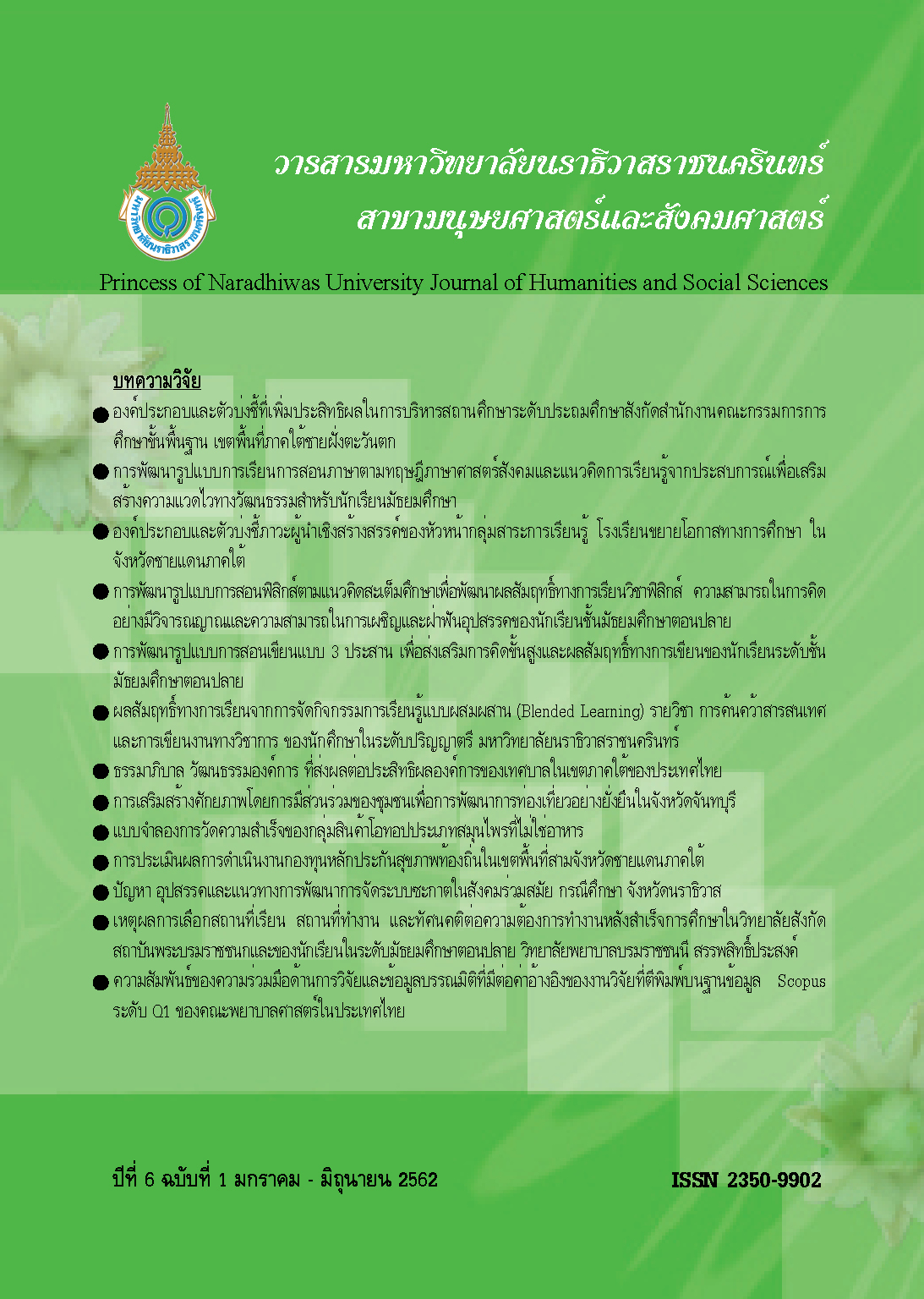The Association of Research Collaboration and Bibliometrics Data with Citation Impact among Articlesbased on Scopus Q1 from Nursing Institutions in Thailand
Main Article Content
Abstract
This cross sectional study proposed to study characteristics ofresearch collaborationand bibliometrics datain international research articles of faculty of nursing, Mahidol university and other faculty of nursing in Thailand. Furthermore, this article indicatedassociation of research collaboration and bibliography on citation impact by using non-parametric of one-way ANOVA test (Kruskal-Wallis Test) for comparison citationin each collaboration groups. The log-linear regression model was used in next step to be consistent with the distribution of citation impact value was not normal distribution and right skewed. The sample size were 194 research articles of Thai faculty of nursing published in the Scopus database and journal in quartile ranking 1 for control same quality ofjournal publication.
The Results shown that research articles had average number of authors about 4 (mean = 4.45; S.D. = 3.19) and average number of institutions about 2-3 (mean = 2.70; S.D. = 2.41). More than 63 percent of research articles were article with bilateral international collaboration and about 8.8 percent were article with multilateralcollaboration. The Result of Kruskal-Wallis Test revealed that articles with more than 6 authors has statistically significant higher citation rate than other groups. In term of log-linear regression analysis, factors that influenced citation rate per year such as number of references, number of authors and H-Index of first authors with R2 = 0.165 (Adjusted R2 = 0.138). For another independent variables (FWC Index), number of references was only one factor that can be significant influence factor. The result can be used to planning for international research publication to increase the quality of research and increase opportunities for research to be utilized. Researcher must consider literature review to cover the research field and the importance thing to consider is about research collaboration with famous researcher or researcher with high impact in the field.
Article Details
References
กิตติกา กาญจนรัตนากรและกิตติภัต เจริญขวัญ. (2558). ความร่วมมือด้านการวิจัยกับนานาชาติต่อคุณภาพผลงานวิจัยของคณะแพทยศาสตร์ มหาวิทยาลัยเชียงใหม่. เชียงใหม่เวชสาร, 54(4), 171-184.
กองบริหารงานวิจัยสานักงานอธิการบดี มหาวิทยาลัยมหิดล. (2016). ยุทธศาสตร์การวิจัย พ.ศ. 2559-2562 (Research Strategy 2016-2019).
ประณีต ส่งวัฒนา. (2552). สถานภาพและทิศทางการวิจัยทางการพยาบาล : มุมมองจากประสบการณ์. วารสารมหาวิทยาลัยนราธิวาสราชนครินทร์, 1(1). 21-27
ศุภลักษณ์ วัฒนาเฉลิมยศ. (2559). การวิเคราะห์สมรรถนะการวิจัยและเครือข่ายความร่วมมือการวิจัยขององค์กรผ่านโปรแกรม. วารสารบัณฑิตศึกษา มหาวิทยาลัยราชภัฏสกลนคร, 13(61), 243-252.
สุทธิศักดิ์ ศรีสวัสดิ์. (2560). ปัจจัยที่มีอิทธิพลต่อจำนวนครั้งการถูกอ้างอิงของบทความวิจัยทางการพยาบาลของประเทศไทยที่ตีพิมพ์บนฐานข้อมูล Scopus: ใช้การวิเคราะห์แบบการถดถอยทวินามเชิงลบที่มีค่าศูนย์มาก. วารสารสารสนเทศศาสตร์, 35(3), 1-23.
Agarwal, A., Durairajanayagam, D., Tatagari, S., Esteves, S. C., Harlev, A., Henkel, R., . . . Bashiri, A. (2016). Bibliometrics: Tracking research impact by selecting the appropriate metrics. Asian Journal of Andrology, 18(2), 296-309.
Annalingam, A., Damayanthi, H., Jayawardena, R., & Ranasinghe, P. (2014). Determinants of the citation rate of medical research publications from a developing country. SpringerPlus, 3(1), 1-6.
Bornmann, L. (2017). Is collaboration among scientists related to the citation impact of papers because their quality increases with collaboration? An analysis based on data from F1000Prime and normalized citation scores. Journal of the Association for Information Science and Technology, 68(4), 1036-1047.
Bornmann, L., & Daniel, H. D. (2010). Citation speed as a measure to predict the attention an article receives: An investigation of the validity of editorial decisions at Angewandte Chemie International Edition. Journal of Informetrics, 4(1), 83-88.
Bornmann, L., Mutz, R., Neuhaus, C., & Daniel, H. D. (2008). Citation counts for research evaluation: Standards of good practice for analyzing bibliometric data and presenting and interpreting results. Ethics in Science and Environmental Politics, 8(1), 93-102.
Cartes-Velásquez, R., & Manterola, C. (2017). Impact of collaboration on research quality: A case analysis of dental research. International Journal of Information Science and Management, 15(1), 89-93.
Cheng, K. L., Dodson, T. B., Egbert, M. A., & Susarla, S. M. (2017). Which Factors Affect Citation Rates in the Oral and Maxillofacial Surgery Literature? Journal of Oral and Maxillofacial Surgery, 75(7), 1313-1318.
Didegah, F., & Thelwall, M. (2013). Which factors help authors produce the highest impact research? Collaboration, journal and document properties. Journal of Informetrics, 7(4), 861-873.
Field, A. (2009). Discovering Statistics Using SPSS: SAGE Publications.
Figg, W. D., Dunn, L., Liewehr, D. J., Steinberg, S. M., Thurman, P. W., Barrett, J. C., & Birkinshaw, J. (2006). Scientific collaboration results in higher citation rates of published articles. Pharmacotherapy, 26(6 I), 759-767.
Hanssen, T. E. S., Jørgensen, F., & Larsen, B. (2017). The relation between the quality of research, researchers’ experience, and their academic environment. Scientometrics, 1-18.
Ibáñez, A., Bielza, C., & Larrañaga, P. (2013). Relationship among research collaboration, number of documents and number of citations: A case study in Spanish computer science production in 2000-2009. Scientometrics, 95(2), 689-716.
Shang, S., Nesson, E., & Fan, M. (2018). Interaction terms in Poisson and log linear regression models. Bulletin of Economic Research, 70(1), E89-E96.
Sud, P., & Thelwall, M. (2016). Not all international collaboration is beneficial: The Mendeley readership and citation impact of biochemical research collaboration. Journal of the Association for Information Science and Technology, 67(8), 1849-1857.
Tan, H. X., Ujum, E. A., Choong, K. F., & Ratnavelu, K. (2015). Impact analysis of domestic and international research collaborations: A Malaysian case study. Scientometrics, 102(1), 885-904.
Van Dalen, H. P., & Henkens, K. (2005). Signals in science - On the importance of signaling in gaining attention in science. Scientometrics, 64(2), 209-233.


